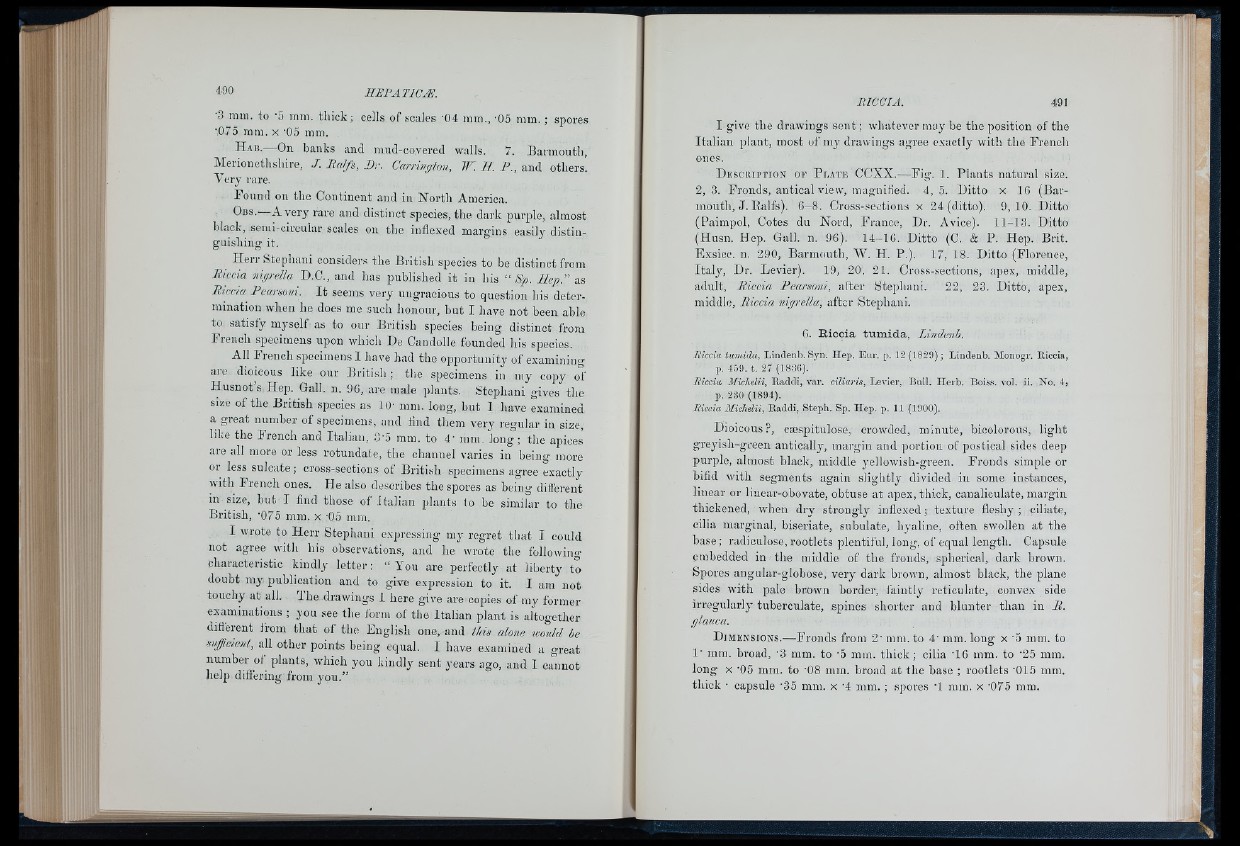
I il'il
I i'iLIM
II 1
■3 mm. to A mm. thick; ceils of scales '04 mra., -05 mm.; spores
•,07o rnm. x '05 mm.
H a« .—On banks and mud-eo.vered walls. 7. Barmouth.
Merionethshire, J. Ealfs, Dr. Carrington, JF. IL P., and others.
Very rare.
Found on the Continent and in North America.
Obs.—A very rare and distinct species, the dark purple, almost
black, semi-circular scales on the inflexed margins easily distinguishing
it.
Herr Stephani considers the British species to be distinct from
Piccia nigrella D.C., and has published it in his “ Sqj. Hep.” cm
Piccia Pearsoni. I t seems very ungracious to question his determination
when he does me such honour, but I have not been able
to satisfy myself as to our British species being distinct from
French specimens upon which He Candolle founded his species.
All French specimens I have had the opportunity of examining
arc dioicous like our B ritish ; the specimens in luy copy of
Husnot s Hep. Gall. n. 9G, are male plants. Stephani gives the
size of the British species as 10' mm. long, but 1 have examined
a great number of specimens, and find them very regular in size,
like the French and Italian, 3 A mm. to 4 ’ mm. lo n g ; the apices
are all more or less rotundate, the channel varies in being more
or less sulcate; cross-sections of British specimens agree exactly
with French ones. He also de.soribes the spores as being different
in size, but I find those of Italian plants lo be similar to the
British, '075 mm. x -05 mm.
I wrote to Herr Stephani expressing my regret that I could
not agree with his observations, and he wrote the ibllowino-
characteristic kindly letter; “ You are perfectly at liberty to
doubt my publication and to give expression to it. I am not
touchy at all. The drawings I here give are copies of my former
examinations ; you see the iorm of the Italian plant is altogether
diHerent from that of the English one, and this alone would be
suficieut, all other points being equal. I have examined a great
number of plants, which you kindly sent years ago, and I cannot
help differing from you.”
I give the drawings sent ; whatever may be the position of the
Italian plant, most of my drawings agree exactly with the French
ones.
Description of P late CCXX.—Fig. 1. Plants natural size.
2, 3. Fronds, antical view, magnified. 4, 5. Ditto x IG (Barmoutli,
J. Ralfs). C-8. Cross-sections x 24 (ditto). 9,10. Ditto
(Paimpol, Cotes du Nord, France, Dr. Avice). 11-13. Ditto
(Husn. Hep. Gall. n. 96). 14-1G, Ditto (C, & P. Hep. Brit.
Exsicc. n. 290, Barmouth, W. H. P.). 17, 18. Ditto (Florence,
Italy, Dr. Levier). 19, 20, 21. Cross-sections, apex, middle,
adult, Riccia Pearsoni, alter ¡Stephani. 22, 23. Ditto, apex,
middle, Riccia nigrella, after Stephani.
6. Riccia tumida, Lindenb.
Piccia tumida, Lindenb, Syn. Hep. Eur. p. 1 2 (1 8 2 9 ); Lindenb. Monogr. Riccia,
p. 459. t. 27 (183G).
Piccia Mictwlii, Raddi, var. ciliaris. Levier, Bull. Herb. Boiss. vol. ii. No. 4,
p. 230 (1894).
Piccia Michdii, Raddi, Steph. Sp. Hep. p. 11 (1900).
Dioicous?, cæspitulose, crowded, minute, bicoloroiis, light
greyish-green antioally, margin and portion of postical sides deep
purple, almost black, middle yellowish-green. Fronds simple or
bifid with segments again slightly divided in some instances,
linear or linear-obovate, obtuse at apex, thick, canaliculate, margin
thickened, when dry strongly inflexed ; te.xture fleshy ; ciliate,
cilia marginal, biseriate, subulate, hyaline, often swollen at the
base ; radiculose, rootlets plentiful, long, of equal length. Capsule
embedded in the middle of the fronds, spherical, dark brown.
Spores angular-globose, very dark brown, almost black, the plane
sides with pale brown border, faintly reticulate, convex side
irregularly tuberculate, spines shorter and blunter than in R.
glauca.
Dimensions.— Fronds from 2' min. to 4' mm. long x A mm. to
1" mm. broad, '3 mm. to A min. thick; cilia T6 mm. to '25 mra.
long X -05 mm. to ’08 mm. broad at the base ; rootlets '015 mm.
thick • capsule '35 mm. x '4 mm. ; spores T mm. x '075 mm.